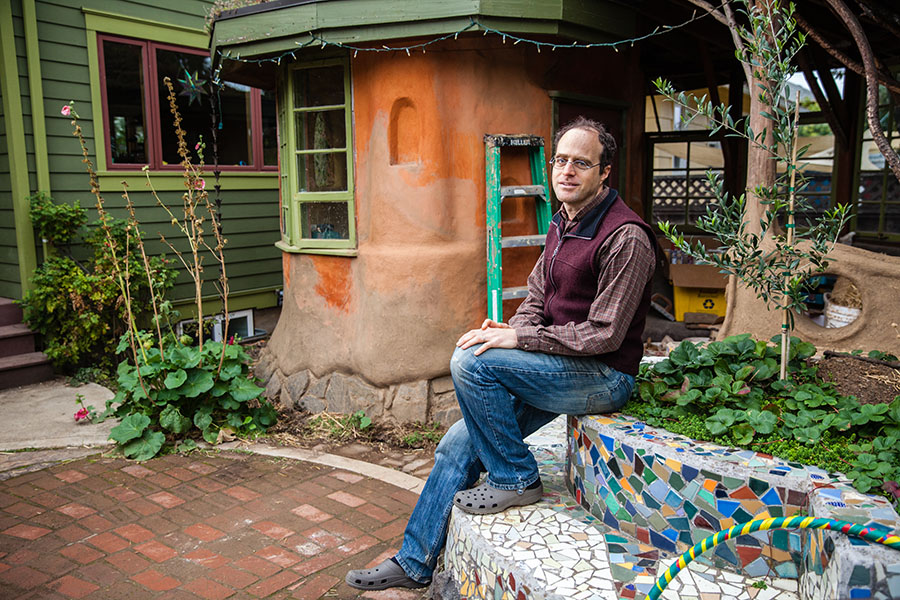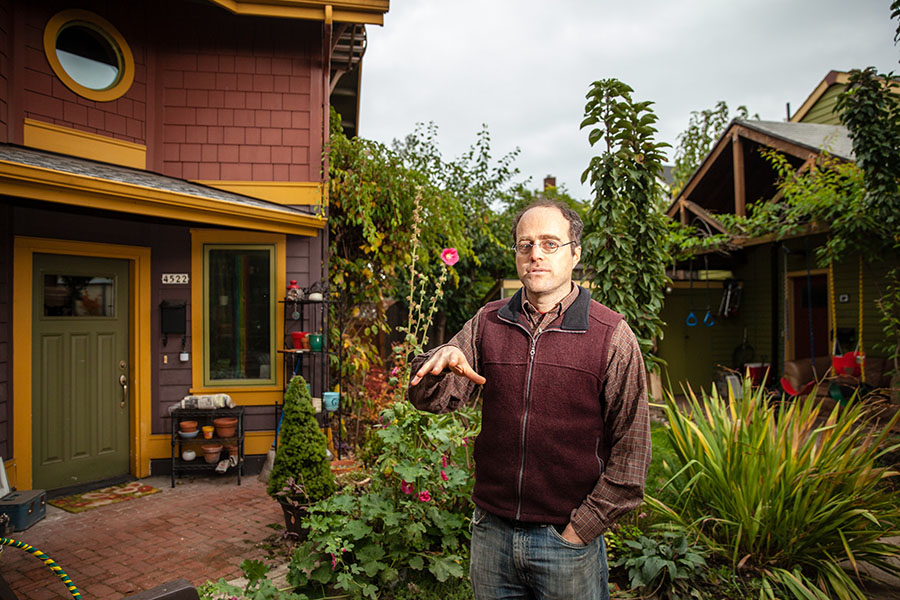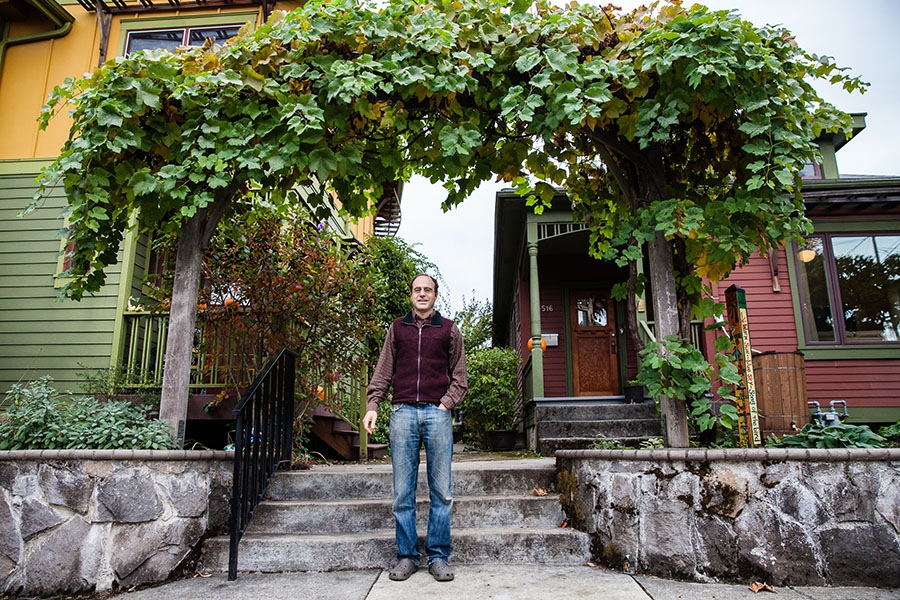Eli Spevak hammers out policy.
Something new is rising amid the large-lot, single-family homes on Northeast Mason Street in Portland.
The wooden frames of 13 market-rate and affordable rowhouses, in various stages of completion, nestle in an L shape around an existing, 840-foot residence to create a central courtyard. An adjacent concrete pad will hold a common house: a space for future residents of Mason Street Townhomes to meet, share meals and host movie nights.
The communal arrangement, along with the homes’ small size, stands in direct contrast to most of Portland’s newly built housing stock. “I’m experimenting,” says Eli Spevak, who helms Orange Splot, a Portland housing developer.
RELATED STORY: TAKING IT TO THE STREETS
Development is an ongoing experiment for Spevak. A self-proclaimed policy geek turned boutique builder, he crafts small houses that encourage community by design. Spevak is hyper local, only taking projects he can bike to from his Cully neighborhood.
He is also hands-on, serving as developer and general contractor. The work may be small, but it’s in service of a larger goal: Keep Portland affordable, desirable and livable by constructing new housing models and writing new housing regulations.
“Orange Splot pays for my policy habit,” he says with a wry smile.
As a member of the city’s planning and sustainability commission, Spevak wrestles with the complicated mix of forces driving Portland’s mounting housing crisis. As a builder, he’s small but mission driven, averaging about 12 homes a year with annual revenues between $100,000 and $200,000.
Can a boutique developer with his heart in the right place make real change in a city where housing prices and rents are locking out middle-class workers and residents?
Seventy percent of new households earn more than $100,000 a year—well above the regional median of $63,850, according to a report by the Metro regional government.
Developers are catering to this deep-pocketed influx with huge, expensive homes, luxury apartments with pricey rents and not much for anyone else.
RELATED STORY: UNSHAKEABLE: BEN KAISER HOLDS HIS GROUND
Spevak aims to fill the gap. Born in Washington, D.C., he moved to Portland in 1994 to volunteer for Habitat for Humanity. He then spent 10 years managing the finance and construction of over 250 affordable housing units through different nonprofits.
“I was geeking out on zoning code,” he remembers.
But Spevak missed the jobsite. Navigating the complexities of affordable-housing financing “can kill a lot of brain cells,” he recalls. Feeling distant from the work, he took a year off to develop his first experiment, Peninsula Park Commons — a building containing seven small, private condominiums clustered around a large communal space with shared amenities.
Upon completion he and his wife, Noelle Studer-Spevak, moved in.
Like many young people new to a city, Spevak shared a group house for years out of necessity. He treasured the camaraderie and communal amenities but wanted “more independence and my own front door.” This project was, in his mind, the best of both worlds.
 Emboldened by the success of Peninsula Park Commons and freed from the rigid financing rules of the affordable-housing world,Spevak developed and built a variety of small-footprint, co-living experiments.
Emboldened by the success of Peninsula Park Commons and freed from the rigid financing rules of the affordable-housing world,Spevak developed and built a variety of small-footprint, co-living experiments.
Sabin Green, a four-home, co-housing community in Northeast, and the two small “detached bedrooms” of Ruth’s Garden Cottages proved that the granny flat (also known as an accessory dwelling unit, or ADU) could succeed in Portland.
He and other green building enthusiasts persuaded Portland to tweak zoning rules and waive system development charges in 2010 to encourage more.
It worked. Before the rule changes the city permitted between 20 to 30 ADUs a year. After 2010 that number jumped to one a day.
RELATED STORY: OUTSIDE THE BOX: KEVIN CAVANAUGH REVITALIZES THE CITY
Spevak is experimenting with other housing types as well. Cully Grove, where his family (now grown to include two children) lives, includes 16 homes most in two- or three-unit buildings, as well as a shared common house and community garden on two acres. Mason Street tries to bring the townhouse, a fixture back in his native D.C., to Portland.
With the inherent environmental benefits of a shared wall (fewer construction materials, better use of space, more efficient heating and cooling), it’s a puzzle why there aren’t more. “I blame Oregonians’ ‘frontier’ attitude,” Spevak muses. “People want their own four walls. I want to prove that townhomes can be attractive and successful.”
He’s also tinkering with an old model turned trendy again. Co-living, after all, where people rent a bedroom and share common spaces, is just a fancy term for boarding house.
The modern version stresses community and uses mobile apps for everything from paying rent to sharing food. Spevak is partnering with Open Door — an Oakland, California company that has created three co-living communities in the Bay Area — to build a yet unnamed project on Northeast 43rd between Sumner and Emerson.
The new-construction project on two single-family lots will feature big common areas and private bedrooms/baths. Rent will run around $700, and Spevak will be the landlord. “It will be nice to get a little income,” he says.
Spevak thinks the co-living model would work well in the stately old homes found in Portland’s traditional family neighborhoods too. It’s a controversial idea, as zoning rules in those iconic areas — think Laurelhurst, Alameda — would have to change. But internally dividing these residences preserves architecture and eases the housing crunch, particularly for professionals in their 30s and 40s who are waiting longer to have families yet crave community.
The co-living model is taking hold in other parts of the country as well. Companies like WeLive, Ollie and Common offer furnished bedrooms with shared spaces in expensive cities like New York, San Francisco and Chicago on a month-to-month basis.

It may even become the norm. As the average size of the American family trends down, smaller, more flexible homes make sense. As the sharing economy becomes more accepted, Joe Gebbia, co-founder of Airbnb, told Fast Company last year, future homes will be designed to share from the start. Spevak reports seeing a bit of that starting here. “Big developers are starting to offer ADUs as an add-on to larger homes,” he says.
It’s a trend he gets behind as a way to keep teachers, retail workers and the less affluent in the neighborhood mix. Leading the country in ADU permitting, Portland could be a model for other cities.
Not everyone is convinced. Some claim the ADU is inadvertently making Portland’s housing problem worse, pointing to owners who rent the property on Airbnb or another short-term rental site and further cut down on available housing stock.
Spevak argues against that case. “In 2013 only 6% of ADUs were used as short-term rentals. It’s probably higher now but not by much.” Still, he’s fine with a new zoning rule that does not waive system development charges on any structure built for short-term rental.
“If ADUs are used this way, they are not meeting their public-policy goals.”
Choices like ADUs, co-living apartments and townhouses make market-rate housing more approachable—a smaller house, after all, commands a smaller price tag. But Spevak hasn’t forgotten his affordable-housing roots.
Most of the Mason Street Townhomes will sell for market rate — $350,000 – $525,000 — but three affordable units, priced in the low $200,000, will also be available. Spevak subsidized these units himself, matching what the city adds.
“I’m leaving a lot of money on the table,” he says. “But these neighborhoods are losing their affordable housing, so I want to include some going forward.”
Spevak admits that his high density projects are not a silver bullet for the city’s housing crisis but join a menu of alternatives.
The solutions seem spot on for residents disturbed by the growing size of new construction, neighborhoods that don’t mind getting denser — yes, there are some that don’t— and a cohort of buyers and renters attracted to co-housing and co-living.
As the city puts the finishing touches on its 2035 Comprehensive Plan, all of Portland’s zoning code is in play. Growth may be inevitable, but managing growth effectively takes foresight and hard work. Spevak is laying the groundwork. “I love to experiment. Whatever Portland comes up with, I want to showcase what you can do.”
A version of this article appears in the November/December 2017 issue of Oregon Business.




